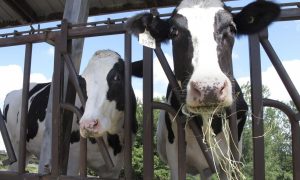
Organic dairy and other livestock farmers are seeking emergency federal aid as they grapple with skyrocketing organic feed costs, steep fuel and utility expenses as well as the consequences of drought in many parts of the country.
Two dozen U.S. senators and representatives wrote to U.S. Agriculture Department Secretary Tom Vilsack this week asking for emergency assistance for these farms. National and regional organic farming groups have also reached out to the department and the heads of the congressional committees.
Organic dairy farmer Abbie Corse, whose more than 150-year-old family farm is located in the southern Vermont town of Whittingham, said she doesn’t know what the future of the farm will look like.
“If a farm like ours is questioning how we’re going to keep going if something doesn’t change, I don’t know how we think there’s a future for anybody,” said Corse, 40, who farms with her mother and father.
On top of the high feed, energy and fuel costs organic farmers are facing, labor is a pressing challenge for The Corse Farm Dairy, which has a herd of about 90 and sells its milk to Organic Valley, an international milk cooperative based in LaFarge, Wisconsin. If anyone is unable to work, the family doesn’t have backup to keep the farm running.
“We are a medical emergency away from selling our herd,” she said.
In May of this year, prices for organic soybeans in the U.S., used as feed on organic farms, soared to $40.52 per bushel, an increase of nearly 110% from January 2021, according to the letter the members of Congress sent to Vilsack on Monday.
Feed costs normally average over half of the organic dairy and poultry farmers’ total production costs “but dramatic increases year-over-year in organic feedstuffs are now creating unsustainable circumstances that could lead to farm closures, reduced competition and ultimately, limited consumer choice,” the letter said.
The war in Ukraine and the Agriculture Department’s discontinuation of the National Organic Program recognition agreement with India has reduced imported grain supplies and pushed up prices, officials said.
The drought in the West and other areas of the country has caused California, the country’s top dairy state, to have its driest three-year stretch on record and, this summer, challenged farmers in the Northeast. Western forages have been depleted and organic alfalfas, hays and sileages are in limited supply and nearly doubled in price, said Albert Straus, the founder and CEO of Straus Family Creamery in Marin County. The creamery has formed a crisis coalition of organic dairy farms, processors and brands in the West to petition for emergency drought relief.
California has lost 10 organic dairies in the last several months and as many as 50 are projected to go out of business if no relief comes in the next couple of months, said Straus. Twelve farms had provided organic milk to the creamery until one recently went out of business, he said.
“I’m concerned that the viability of these farms and the future of our communities is at risk,” Straus said.
U.S. Sen. Patrick Leahy of Vermont, chairman of the Senate Appropriations Committee, said he’s heard from Vermont organic dairy farmers, companies that buy their milk and the state’s agriculture secretary about “the severe financial pressure” organic dairies are facing.
While Leahy, a Democrat, said the longer-term solution must be found in more stable markets and a risk management program that works for organic dairy, he’s confident “that the federal government will find an approach to provide temporary support to our struggling organic dairy farm families.”
A spokesperson said the Agriculture Department “is exploring avenues to address the challenges faced by organic dairy farmers, while also pursuing ongoing work to support organic and transitioning farmers through USDA programs.”
For Kathie Arnold, who farms with her son at Twin Oaks Dairy in the central New York town of Truxton, this is likely one of the most financially difficult periods she has seen since the farm became organic in 1998. They’re going to survive, but for other younger farmers, who bought their farms in recent years and have debt to pay off monthly, “they’re not going to be able to weather this storm,” Arnold said.





















